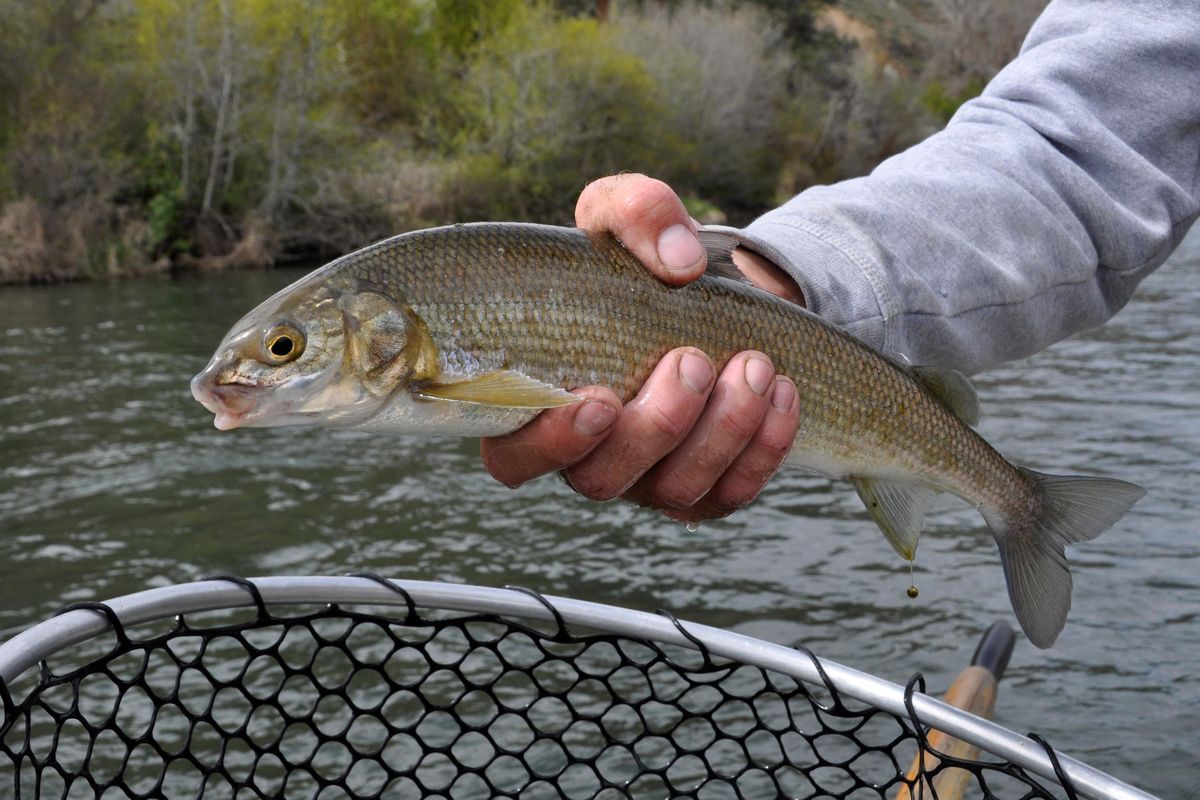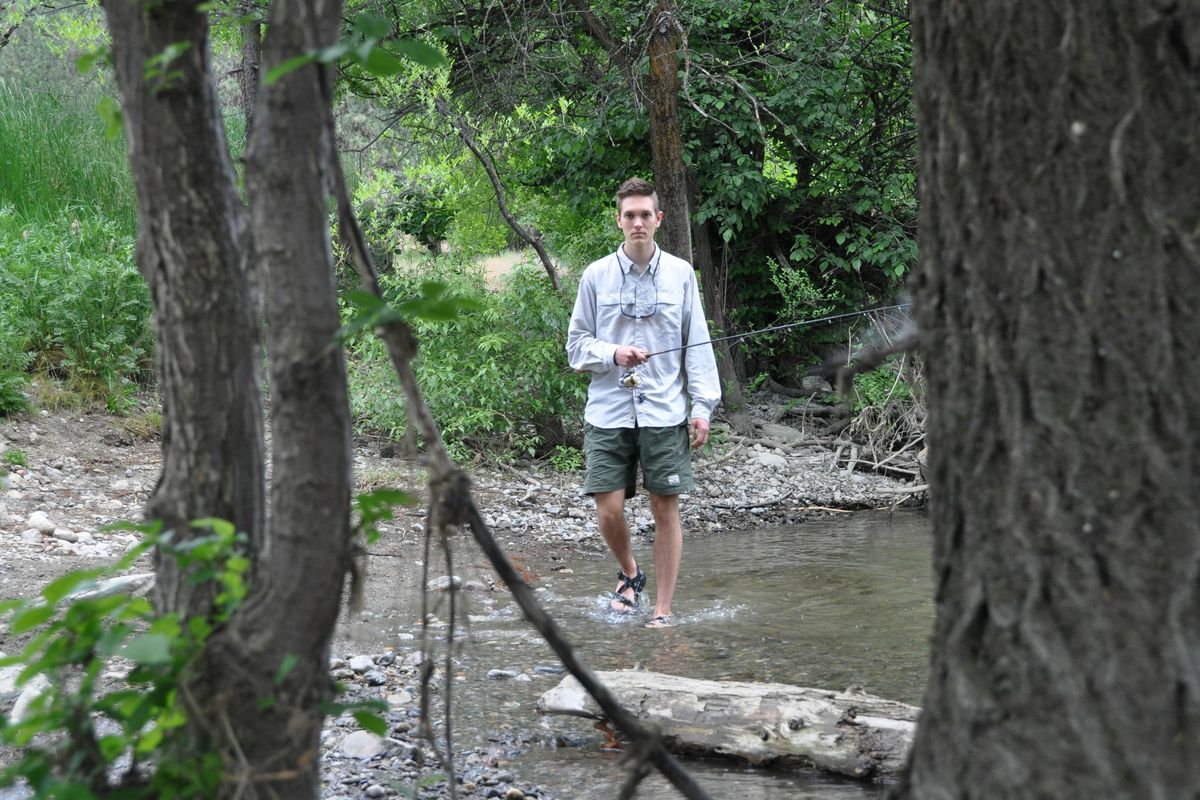High school researcher finds microplastics in Spokane River fish
A mountain white fish (Rich Landers / The Spokesman-Review)
A Spokane high school student applied the “think global, act local” concept to his senior science project and discovered the seeds of a giant ocean problem in the guts of Spokane River whitefish.
“I’ve always loved the Spokane River, so it made sense to focus my project there,” said Isaac Caruso, who was graduated from Lewis and Clark High School last week.
Among the food items the native fish had ingested were microplastics that ranged from little chunks of petrochemical material to microbeads and tiny fibers from synthetic clothing.
“The project is a benefit to the body of work done on the Spokane River,” said Paul Spruell, biology professor at Eastern Washington University.
“We see a lot of press about the growing problem of microplastics in marine environments, but we don’t know that much about them in freshwater environments. I haven’t seen anything like this done in riverine parts of the Columbia Basin, and I must say I’m shocked at how common microplastics are.”
Caruso’s “Investigating the Presence of microplastics in the Gastrointestinal tract of Mountain Whitefish in the Spokane River” project also caught the eyes of judges in the Eastern Washington Regional Science and Engineering Fair. He was one of two east side students awarded an expense-paid trip to the Intel International Science and Engineering Fair in Los Angeles at the end of May.
Judges told him the project concept had PhD-level potential.
“Microplastics are found across the world in rivers, lakes – even alpine lakes,” Caruso said, citing from his research. “They matter because they have a tendency to soak up harmful chemicals like a sponge.”
The microplastics in rivers with chemical pollution can contribute to toxic bioaccumulation that works up the food chain as bigger fish eat smaller fish.
Caruso’s familiarity with the problem and the science in studying microplastics in fish is compelling as he explains how he sorted through previous research, including techniques for extracting the samples from the fish.
The study involved collecting fish, killing them and doing a thorough examination of contents in their gastrointestinal tract. Spokane River redband trout had to be avoided because of state protections to preserve their population, he said.
“Sucker fish are bottom feeders while whitefish feed from the bottom up through the water column,” Caruso said. “Mountain whitefish have a good size range and are more available in winter, which worked out with the timing I had at school.
“Professors I contacted at Gonzaga, EWU and Fish and Wildlife Department biologists thought whitefish would be a pretty good bioindicator.”
Spruell, head of the EWU fisheries program, agreed to help Caruso with fish collection and laboratory facilities.
“When he contacted me, I was impressed at how the project was already well researched and aligned,” Spruell said. “I’ve interacted like this with three or four high school students in my career.”
Spruell arranged the loan of an electrofishing raft provided by the Kalispel Tribe enabling Caruso to shock and net stunned whitefish.
“I’d liked to have done it by hook and line, but that wasn’t feasible,” Caruso said with a smile.
The sampling occurred in two river segments, from T.J. Meenach Bridge down to just below the Spokane Wastewater Treatment Plant and from Ninemile Dam to the Little Spokane River confluence.
Working the river by raft with a generator and bright lights on winter nights wasn’t fun and games.
“I collected 33 whitefish,” Caruso said. “I’d planned to collect more, but the temperatures dropped to 12 degrees the second time out and then it got colder. We had to call it good because the boat trailer would freeze.”
Eastern’s research permits enabled the student to euthanize the whitefish, which ranged from about 7 inches to more than 14 inches long.
The fish were stored in a freezer and Caruso would drive to the Eastern Washington lab during fourth and fifth periods for two months to process the samples.
“I’d looked into pumping the fish stomachs, but that’s not effective in getting out such tiny particles,” he said.
“I’d take out the stomach and gastrointestinal tract, from the esophagus to the anus, put it in a Petri dish and dry it out in an oven at 50 degrees Celsius. Then I’d grind it with mortar and pestle, put it in hyper-saline solution, stir and cause the particles in the stomach to separate.”
Particles that floated were filtered out and put into a 15 percent hydrogen peroxide solution to dissolve organic material such as, say, ground up midge nymphs.
At the end of the process, he found up to three microplastics per fish.
“When he was processing the very first fish, he sat down at the microscope and I told him to come get me if he saw anything interesting,” Spruell said. “About five minutes later, he came to my office and said, ‘Hey, you gotta come look at this.’ ”
“Compared with other studies, the numbers I was finding were very biologically relevant,” Caruso said.
“Chelsea Rochman of Canada, the world’s foremost microplastics researcher, found that microplastics can cause problems such as increased rates of single-cell necrosis. A biorelevant amount of microplastics can increase the odds of kidney damage.”
He said microplastics could cause biomagnification of the problems associated with chemicals such as PCBs.
“I fly fish in the Spokane River, and I’ve run it in rafts and whitewater kayak, so I know the river, and I’ve heard about its pollutants,” Caruso said. “There’s been a lot of work done on chemical pollutant problems such as PCBs. There’s already a lot of good monitoring and it’s all leading to solutions.”
In the limited previous research he was able to study on microplastics in rivers, Caruso found a study that documented the material in 12 percent of the fish in a river in Italy and 45 percent of the fish in a river in Texas.
Of the 33 fish he collected from the Spokane River, 66 percent had microplastics, according to Caruso’s research.
The whitefish upstream from the Wastewater Treatment Plant contained slightly more microplastics than those collected below Nine Mile Dam.
Positive changes already are being made, he said.
In 2015, President Barack Obama signed a bipartisan bill that prohibits selling and distributing products containing microbeads. The EPA is phasing in the rule to protect the nation’s waterways.
A microbead is any solid plastic particle less than 5 millimeters that’s used in skin exfoliating or cleansing products and even in toothpaste, according to the bill.
“Michael Cannon (Spokane’s wastewater lab supervisor) said that in about a year and a half new treatment facilities will be filtering out more microplastics before the treated water goes into the Spokane River,” Caruso said.
“Advanced filtration systems need to be implemented nationwide, but they’re really expensive.”
Other remedies include better filtration in washing machines and coatings that can be applied to synthetic cloth to prevent them from shedding microfibers, he said.
Caruso, who will continue his education this fall at the University of Massachusetts-Amherst, hasn’t firmed up his major field of study. But in his first 18 years of life, he’s proved that he’s hardwired at least with a fascination for aquatic life.
The Spokesman-Review published a photo of Caruso in 2005 after a staff photographer found him wading barefoot in Cannon Hill Park Pond focused on hunting water critters with a net.
“When I was 16, my folks asked me what I wanted to do for my birthday and I said right off, ‘Camping on the St. Joe River,’ ” he said, noting that he started fly fishing around third grade.
“Fishing is definitely a part of me.”

